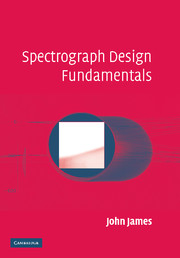Book contents
- Frontmatter
- Contents
- Preface
- Acknowledgements
- 1 A brief history of spectroscopy
- 2 The relevant regions of the electromagnetic spectrum
- 3 Geometrical optics
- 4 Optical aberrations
- 5 Fourier transforms: a brief revision
- 6 Physical optics and diffraction
- 7 The prism spectrograph
- 8 The plane grating spectrograph
- 9 The concave grating spectrograph
- 10 The interference spectrograph
- 11 The multiplex spectrometer
- 12 Detectors
- 13 Auxiliary optics
- 14 Optical design
- 15 Mechanical design and construction
- 16 Calibration
- 17 The alignment of a spectrograph
- Appendix 1 Optical aberrations
- Appendix 2 Wavelengths of spectral lines for calibration
- Appendix 3 The evolution of a Fabry–Perot interference spectrograph
- Appendix 4 The common calibration curve in silver halide spectrophotometry
- Bibliography
- Index
15 - Mechanical design and construction
Published online by Cambridge University Press: 02 September 2009
- Frontmatter
- Contents
- Preface
- Acknowledgements
- 1 A brief history of spectroscopy
- 2 The relevant regions of the electromagnetic spectrum
- 3 Geometrical optics
- 4 Optical aberrations
- 5 Fourier transforms: a brief revision
- 6 Physical optics and diffraction
- 7 The prism spectrograph
- 8 The plane grating spectrograph
- 9 The concave grating spectrograph
- 10 The interference spectrograph
- 11 The multiplex spectrometer
- 12 Detectors
- 13 Auxiliary optics
- 14 Optical design
- 15 Mechanical design and construction
- 16 Calibration
- 17 The alignment of a spectrograph
- Appendix 1 Optical aberrations
- Appendix 2 Wavelengths of spectral lines for calibration
- Appendix 3 The evolution of a Fabry–Perot interference spectrograph
- Appendix 4 The common calibration curve in silver halide spectrophotometry
- Bibliography
- Index
Summary
Mechanical motions, automatic adjustments and electro-mechanical monitoring and position sensors are so diverse, and the range of transducers and electric motors for remote focusing, wavelength shifting and measuring so vast that there is no point here in listing them or criticising their relative merits. So much depends on the specification of the instrument and the capability of the available workshops that it must be left to the builder to decide how the instrument shall be controlled. The simplest possible mechanical construction is shown here – handles to turn to adjust grating turntables, capstan-bar mirror adjustments and so on, and the improvement of these by other means is clearly up to the designer and the size of his purse. This chapter therefore is confined to those matters which are peculiar to spectrograph construction.
The optical layout
The positions of the optical components will have been decided by the final version of the design coming from the ray-tracing program. The position tolerance for the mirrors is ±0.5mm on both x- and z-axes, the small errors being taken up when focusing.
It remains to dress them in appropriate mountings and assemble the mountings either on to an optical table or into a tube or a space-frame.
The art of constructing a scientific instrument is different from that of engineering mechanisms. The loadings are generally lighter and the precision as high as that of a machine tool or an internal combustion engine, and different criteria apply.
- Type
- Chapter
- Information
- Spectrograph Design Fundamentals , pp. 150 - 167Publisher: Cambridge University PressPrint publication year: 2007



